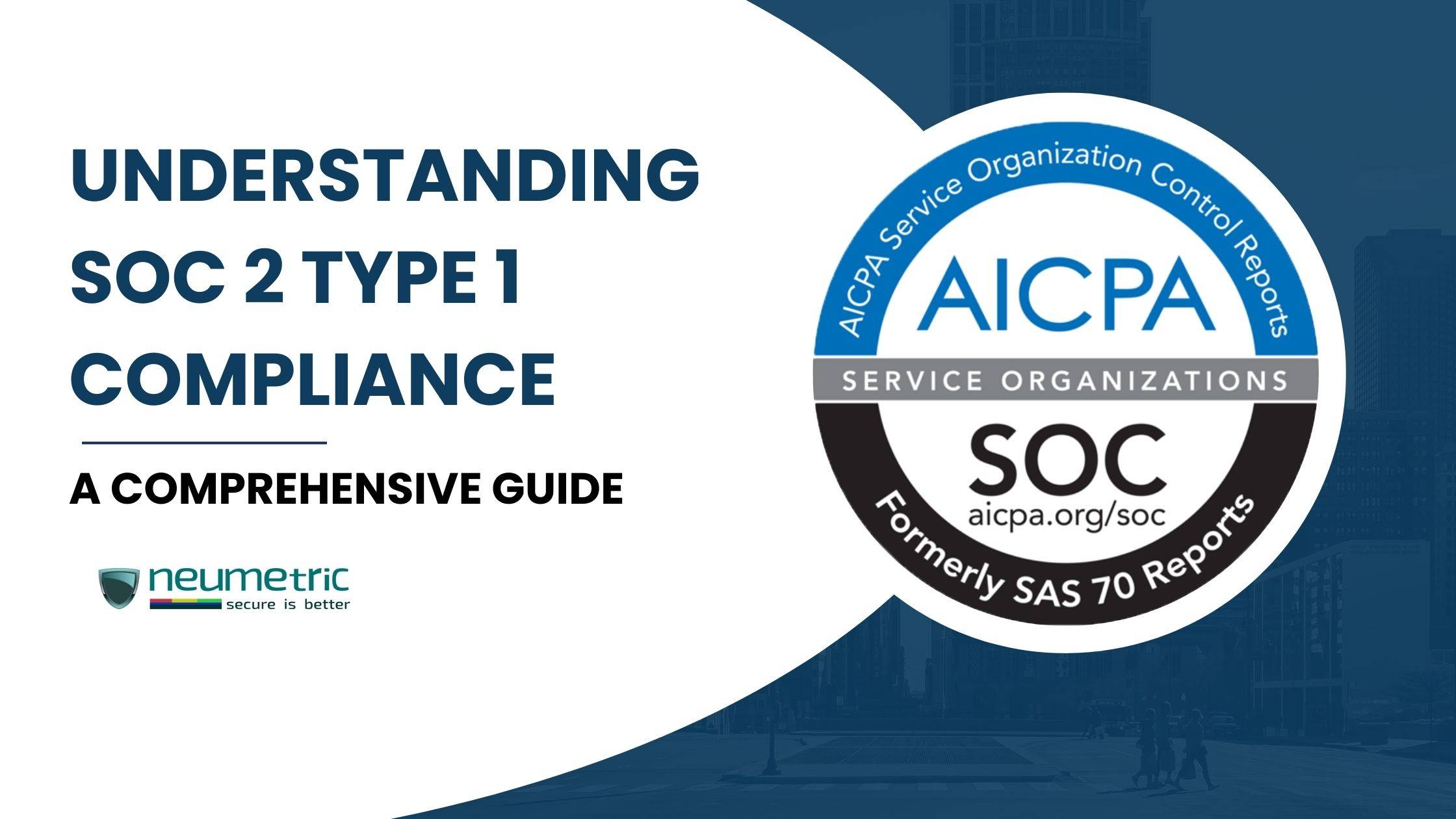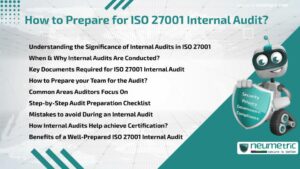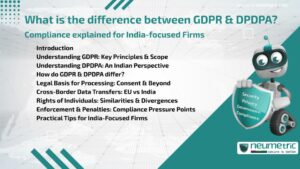Table of Contents
ToggleUnderstanding SOC 2 Type 1 Compliance: A Comprehensive Guide
Introduction
Service Organization Control 2 [SOC 2] is an Auditing Framework developed by the American Institute of Certified Public Accountants [AICPA] that measures a Service Organisation’s ability to protect Customer Data & maintain the privacy & security of information. It is a framework that provides information to users of financial statements about the quality of management, operational & control systems & the corporation’s processes. SOC 2, although not legally mandated, has gained growing significance for businesses to showcase their dedication to robust security & data protection practices. Conducting a SOC 2 Audit is highly valuable for businesses as it boosts customer trust, offers a competitive edge, ensures compliance, reduces risks & fosters partnerships with larger organisations.
SOC 2 Type 1 Compliance Report is an attestation of controls at a Service Organisation at a specific point in time. It assesses the design of Security Processes & Controls rather than their effectiveness. It provides a snapshot of the controls in place at specific point in time & is typically used to address concerns about Security & Compliance.
What is SOC 2 Type 1 Compliance?
A SOC 2 Type 1 Audit assesses the design & suitability of controls at a specific point, focusing on their effectiveness in meeting Trust Services Criteria (Security, Availability, Processing Integrity, Confidentiality & Privacy). It provides a snapshot of control design without assessing long-term operating effectiveness.
For businesses undergoing their initial SOC 2 Audit, a Type 1 Audit is recommended as a starting point. It enables the assessment of control design, identifying gaps or deficiencies prior to a more comprehensive evaluation. Type 1 Audits provide assurance to clients or stakeholders regarding the specific moment’s design & implementation of controls.
The process of obtaining SOC 2 Type 1 Report is that a Service Organisation must engage an independent auditor to perform an examination of their controls. The Auditor will evaluate the design of the controls & provide an opinion on their effectiveness at a specific point in time.
Differences between SOC 2 Type 1 & SOC 2 Type 2 compliance
Coverage Period: The Primary difference between SOC 2 Type 1 & Type 2 is the coverage period. A SOC 2 Type 1 Report is issued for controls implemented at a specific point in time, whereas a SOC 2 Type 2 Report covers a period of time typically 3-12 months. This means that the Type 2 Report provides a more comprehensive view of the effectiveness of the controls over time, while the Type 1 Report only provides a snapshot of the controls at a specific point in time.
Testing Duration: The Testing Duration is another key difference between SOC 2 Type 1 & Type 2 Reports. A Type 1 Report only requires one test of the controls, whereas a Type 2 Report requires Multiple Tests over the coverage period. This means that Type 2 Report provides more thorough Testing & Assurance of the effectiveness of the controls.
Testing Frequency: The Frequency of Testing is also different between SOC 2 Type 1 & Type 2 Reports. Type 1 Report only requires testing of the controls once, whereas Type 2 Report requires testing of the controls on an ongoing basis. This means that the Type 2 Report provides more assurance about the ongoing effectiveness of the controls.
Nature of Testing: The Nature of Testing is also different between SOC 2 Type 1 & Type 2 Reports. A Type 1 Report only assesses the design of the controls, whereas Type 2 Report assesses both the design & effectiveness of the controls. This means that Type 2 Report provides more comprehensive assurance about the controls in place
Benefits of achieving SOC 2 Type 1 Compliance
Below are the 5 benefits to get SOC 2 Type 1 certification for your organisation.
- Competitive Edge for Startups
- Shorter Sales Cycle
- Immediate Requirement
- Cost Effective
- Kickstarts Compliance
Scope & Criteria of SOC 2 Type 1 Compliance
SOC 2 Type 1 Compliance is a certification that ensures a company’s systems & controls are designed & implemented to meet certain security, availability, processing integrity, confidentiality & privacy standards. The scope & criteria of SOC 2 Type 1 Compliance are as follows:
Scope:
The scope of SOC 2 Type 1 Compliance is focused on the design & implementation of a company’s controls related to security, availability, processing integrity, confidentiality & privacy.
The certification is based on a point-in-time evaluation of the company’s controls & does not include an assessment of their effectiveness over a period of time.
Criteria:
The criteria for SOC 2 Type 1 Compliance are based on the Trust Services Criteria [TSC] developed by the American Institute of Certified Public Accountants [AICPA]. The TSC includes five categories of criteria: security, availability, processing integrity, confidentiality & privacy.
The criteria are designed to ensure that a company’s controls are effective in protecting the confidentiality, integrity & availability of its systems & data. The criteria are also designed to ensure that a company’s controls are aligned with industry best practices & standards.
Steps to Achieve SOC 2 Type 1 Compliance
The SOC 2 Type 1 Audit preparation process involves several steps to ensure that the Service Organisation is ready for the Audit. These steps are:
- Scoping & Planning: The first step is to define the Scope of the Audit, which includes identifying the systems, processes & control objectives to be evaluated.
- Gap Analysis: The Service Organisation conducts a comprehensive Gap Analysis to identify any control deficiencies or areas where it does not meet the TSC requirements.
- Remediation: Based on the Gap Analysis, the Service Organisation addresses the control deficiencies by implementing or enhancing controls to meet the TSC requirements.
- Documentation & Evidence Gathering: The Service Organisation prepares the necessary documentation to support the implementation & effectiveness of its controls.
- Pre-Audit Testing: Before the actual Audit, the Service Organisation may perform pre-audit testing to assess the effectiveness of its controls & ensure they are operating as intended.
- Audit Fieldwork: The SOC 2 Type 1 Audit typically involves on-site or remote fieldwork conducted by the Auditor. During this phase, the Auditor performs testing procedures to evaluate the design & operating effectiveness of the controls.
- Audit Findings & Report: After completing the Audit fieldwork, the Auditor provides the Service Organisation with a report that outlines the findings.
- Remediation & Follow-up: If any control deficiencies are identified, the Service Organisation should address them by implementing appropriate remediation measures.
During the SOC 2 Type 1 Audit, the Service Organisation can expect the Auditor to:
- Evaluate the design & implementation of controls.
- Assess the alignment of controls with the TSC requirements.
- Review documentation, Interview personnel & Request evidence.
- Identify & report control deficiencies.
- Provide recommendations for improvement.
Preparing for a SOC 2 Type 1 Audit involves careful planning & preparation. Some tips to help you in this process are: understand the SOC 2 Type 1 Framework, create a readiness checklist, conduct a gap analysis, establish Policies & Procedures, implement controls & processes, educate & train employees, conduct mock Audits, document evidence, engage external experts, continuously monitor & improve.
Benefits of SOC 2 Type 1 Compliance
Speed up your sales cycle: The SOC 2 Report provides third-party-certified answers to questions any prospect may pose. Providing SOC 2 Report in the RFIs of potential clients speeds up the sales cycle.
Lower audit costs: An audit for a SOC 2 Type 1 Report is generally less costly since auditors require less time & evidence to review to determine the compliance position of a service organisation. SOC 2 Type 1 Compliance should be adequate for the short term.
Competitive Advantage: SOC 2 Type 1 Report will be beneficial when the Competitors do not hold any SOC 2 Compliance.
Increased customer trust: SOC 2 Type 1 certification demonstrates to the customers that an organisation has implemented security & compliance controls & is committed to protecting customer data.
Improved internal processes: By undergoing SOC 2 Type 1 Audit, an Organization’s Internal process significantly improves & mature over the time.
Maintaining SOC 2 Type 1 Compliance
Maintaining SOC 2 Type 1 Compliance requires ongoing effort & attention to detail. Here are some steps that organisations can take to maintain their SOC 2 Type 1 Compliance:
- Conduct regular Risk Assessments: Conduct regular risk assessments to identify new risks to your organisation & update your controls accordingly. This will help ensure that your compliance posture remains up-to-date & effective.
- Implement a security awareness training program: Ensure that all employees are trained on security best practices & understand their role in maintaining compliance.
- Monitor & review controls: Regularly monitor & review your controls to ensure that they are working effectively & are aligned with your compliance objectives.
- Conduct regular Audits: Conduct regular Internal Audits to ensure that your controls are working effectively & to identify any gaps or weaknesses that need to be addressed.
- Stay up-to-date on changes in regulations: Keep up-to-date on changes in regulations & standards that may impact your compliance posture & update your controls accordingly.
By following these steps, organisations can help ensure that they maintain their SOC 2 Type 1 Compliance & continue to protect their customers’ data.
Conclusion
In conclusion, SOC 2 Type 1 Compliance is a certification that evaluates a company’s controls related to security, availability, processing integrity, confidentiality & privacy based on the Trust Services Criteria developed by the AICPA. The certification is focused on the design & implementation of controls & is based on a point-in-time evaluation.
SOC 2 Type 1 Audit holds significant importance for businesses as they enhance customer trust, provide a competitive advantage, align with compliance requirements, mitigate risks & facilitate partnerships with larger organisations. The key steps involved in the SOC 2 Type 1 Audit process include determining the Audit scope, identifying applicable Trust Services Criteria [TSC], developing & implementing Policies & Procedures, performing a Gap Analysis, engaging an Auditor & preparing for the Audit.
FAQs
What is a SOC 2 Type 1?
A SOC 2 Type 1 Compliance assesses the design & suitability of controls at a specific point, focusing on their effectiveness in meeting Trust Services Criteria (Security, Availability, Processing Integrity, Confidentiality & Privacy). It provides a snapshot of control design without assessing long-term operating effectiveness.
What is the difference between Type 1 & Type 2 SOC 2?
SOC 2 Type 1 Report is an attestation of controls at a Service Organisation at a specific point in time. It assesses the design of Security Processes & Controls rather than their effectiveness. It provides a snapshot of the controls in place at specific point in time & is typically used to address concerns about Security & Compliance.
The process of obtaining SOC 2 Type 1 Report is that a Service Organisation must engage an independent auditor to perform an examination of their controls. The Auditor will evaluate the design of the controls & provide an opinion on their effectiveness at a specific point in time.
SOC 2 Type 2 Report is an attestation of controls at Service Organisations over a period of time, typically 3-12 months. It assesses the design & effectiveness of security processes & controls. It provides a more comprehensive assessment of the controls in place & is typically used to address concerns about ongoing compliances.
To Obtain SOC 2 Type 2 Report, an organisation must first undergo an Audit by a Certified Public Accountant [CPA]. The CPA will assess the Organisation’s Controls & issue a Report on their operating effectiveness.
What is SOC 1 vs SOC 2 vs SOC 3 Reports?
SOC 1, SOC 2 & SOC 3 Reports are different types of Reports issued under the Service Organization Control [SOC] framework developed by the American Institute of Certified Public Accountants [AICPA]. SOC 1 Reports, also known as SSAE 18 Reports, focus on controls related to financial Reporting. SOC 2 Reports focus on controls related to security, availability, processing integrity, confidentiality & privacy. SOC 2 Reports can be either Type I or Type II Reports, while SOC 3 Reports are always Type II Reports. SOC 3 Reports are general use Reports that provide a summary of the organisation’s controls without going into detail.
Who needs to be SOC 2 Type 1 compliant?
SOC 2 Type 1 Compliance is relevant for service organisations that store or process sensitive data for their clients. SOC 2 Type 1 Report evaluates the design of the organisation’s internal controls at a particular point in time & assesses whether the implemented controls meet the SOC 2 requirements. Service organisations that want to demonstrate their commitment to security & privacy & assure their clients that they meet SOC 2 standards would benefit from SOC 2 Type 1 Compliance.





